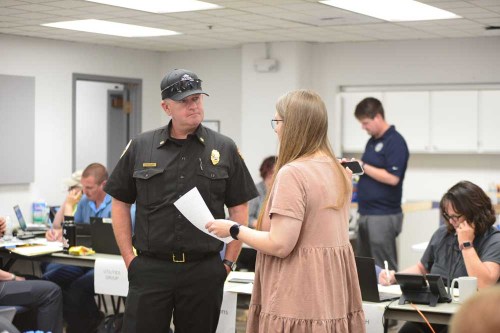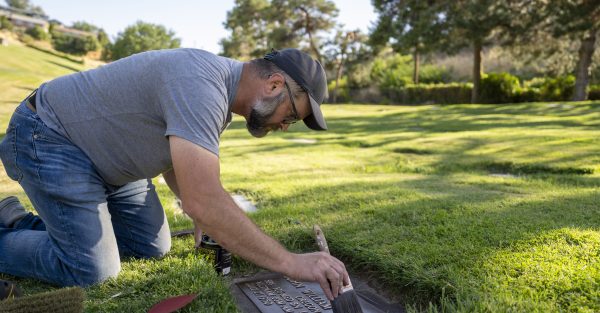Preparing for the Cascadia earthquake
Published 7:00 am Friday, July 1, 2022

- Craig Kretschmer, left, chief of the La Grande Rural Fire Department, and Carrie Brogoitti, public health administrator for the Center for Human Development, talk over responses to emergencies that could be caused in Northeastern Oregon by the Cascadia earthquake during a regional exercise on Monday, June 27, 2022, at the Union County law enforcement building, La Grande.
LA GRANDE — The simulated news was not nearly as alarming as it first sounded.
Elaine LaRochelle, facilities manager at Grande Ronde Hospital, told the Union County participants in a regional Cascadia earthquake exercise on Monday, June 27, that the hospital had just lost its water pressure due to the hypothetical earthquake.
Trending
She said if water pressure was not restored within 12 to 24 hours, Grande Ronde Hospital would have to begin evacuating its patients. LaRochelle explained water pressure was needed not for drinking water but for sanitation purposes.
LaRochelle was not worried, though, for city of La Grande Public Works Department representatives at the simulation informed her the broken pipes causing the pressure drop would be fixed in two hours.
“The La Grande Public Works Department always comes through,” LaRochelle said, referring to her real life experiences with its staff.
Union County joined Baker, Umatilla and Malheur counties in participating in the Cascadia earthquake response simulation on June 27 and June 28. The exercise tested communications, lines of succession, priority assessments such as debris removal, roadway damages, response times and fuel distribution issues the counties would face in the event of a major earthquake.
LaRochelle learned of the fictitious GRH water pressure problem not from a script but from a phone call from a simulated cellphone call center in Pendleton. There people portraying individuals with firsthand information about the status of Union, Baker, Malheur and Umatilla counties following the hypothetical earthquake made calls to update those participating in the exercise.
“The sim cell callers enhanced a sense of realism and authenticity,” said Annette Powers, of Union County Emergency Services.
Trending
Representatives of Grande Ronde Hospital, American Red Cross, city of La Grande, Union County, Oregon Department of Transportation and the Federal Emergency Management Agency participated in the exercise. The representatives of these agencies worked together to address in real time hypothetical emergency situations an earthquake could create. Powers said one of the objectives of the exercise was to get members of organizations that would likely have to work together in the event of an earthquake to get to know one another and learn how their agencies could help one another. She noted that people who have developed professional relationships are able to work more efficiently in an emergency.
LaRochelle said the Cascadia earthquake exercise “cemented” already existing working relationships among local agency representatives.
The participants received sim cell calls about not only falling water pressure but also road-closing mudslides, broken natural gas lines, fallen electrical lines, and supply and food shortages.
In the event of a natural disaster such as the Cascadia earthquake, shortages of essential items could be caused by road closures preventing truck shipments from getting here. Powers said the issue of food shortages was addressed by arranging for the Oregon Department of Transportation to clear roadways for trucks and to do other things to help them transport their food into towns.
Also addressed at the earthquake simulation was the potential for fuel shortages. The delivery of gasoline and diesel also could be affected by closed roads. LaRochelle said fuel shortages could be particularly impactful after an earthquake because there is a good chance power lines will be down, forcing many to rely on diesel generators for their power. LaRochelle said she believes this problem could be addressed by the many generous famers in Union County who have large quantities of fuel stored they would likely share with others.
“The people in this valley are just plain generous,” she said. “I know that people would step up.”
Union County’s resources could be taxed even if the roads leading into it were not closed. Powers noted that if an earthquake hit the Portland area hard it could trigger a mass exodus of people to Northeastern Oregon. Then the question would be if Union County had the resources to meet the needs of the potentially thousands of evacuees who would come here.
Powers said representatives of the American Red Cross addressed this issue during the Cascadia exercise by making plans to get public sheltering facilities in place.
LaRochelle, who was not able to attend the June 28 session of the regional exercise, said people with federal agencies at the June 27 simulation were impressed with how it went.
“They said, ‘You guys just rolled,’” LaRochelle said.
The potential Cascadia earthquake is based on the Cascadia Subduction Zone, a 600-mile fault that runs from Northern California up to Vancouver Island, British Columbia, and is about 70-100 miles off the Pacific coast shoreline. Subduction zone earthquakes can exceed a magnitude of 9.0. While Northeastern Oregon is located far from the center of the subduction zone, the Cascadia earthquake could cause extreme shaking in the region for several minutes that would affect buildings, utilities and transportation.









